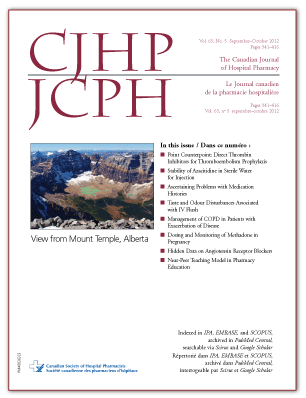Stability of Azacitidine in Sterile Water for Injection
DOI:
https://doi.org/10.4212/cjhp.v65i5.1172Keywords:
azacitidine, drug stability, stabilité des médicamentsAbstract
ABSTRACT
Background: The product monograph for azacitidine states that once reconstituted, the drug may be held for only 30 min at room temperature or 8 h at 4°C. Standard doses result in wastage of a portion of each vial, and the cost of this wastage is significant, adding about $156 000 to annual drug expenditures at the authors’ institution.
Objective: To evaluate the stability of azacitidine after reconstitution.
Methods: Vials of azacitidine were reconstituted with sterile water for injection. At the time of reconstitution, the temperature of the diluent was 4°C for samples to be stored at 4°C or –20°C and room temperature for samples to be stored at 23°C. Solutions of azacitidine (10 or 25 mg/mL) were stored in polypropylene syringes and glass vials at room temperature (23°C), 4°C, or –20°C. The concentration of azacitidine was determined by a validated, stability-indicating liquid chromatographic method in serial samples over 9.6 h at room temperature, over 4 days at 4°C, and over 23 days at –20°C. The recommended expiry date was determined on the basis of time to reach 90% of the initial concentration according to the fastest observed degradation rates (i.e., lower limit of 95% confidence interval).
Results: Azacitidine degradation was very sensitive to temperature but not storage container (glass vial or polypropylene syringe). Reconstitution with cold sterile water reduced degradation. At 23°C, 15% of the initial concentration was lost after 9.6 h; at 4°C, 32% was lost after 4 days; and at –20°C, less than 5% was lost after 23 days.
Conclusions: More than 90% of the initial azacitidine concentration will be retained, with 97.5% confidence, if, during the life of the product, storage at 23°C does not exceed 2 h, storage at 4°C does not exceed 8 h, and storage at –20°C does not exceed 4 days. These expiry dates could substantially reduce wastage and cost where the time between doses does not exceed 4 days.
RÉSUMÉ
Contexte : La monographie de l’azacitadine mentionne que, une fois le médicament reconstitué, on peut le conserver pendant seulement 30 minutes à la température ambiante ou huit heures à 4 °C. Des doses standards entraînent donc le gaspillage d’une partie de chaque flacon et le coût de ce gaspillage est considérable, ajoutant environ 156 000 $ au coût d’acquisition annuel des médicaments à l’établissement de l’auteur.
Objectif : Évaluer la stabilité de l’azacitidine après sa reconstitution.
Méthodes : On a reconstitué le contenu de flacons d’azacitidine avec de l’eau stérile pour injection. Au moment de la reconstitution, la température du diluant était de 4 °C pour les échantillons devant être conservés à 4 °C ou –20 °C et à la température ambiante pour les échantillons devant être conservés à 23 °C. Les solutions d’azacitidine (10 ou 25 mg/mL) ont été conservées dans des seringues de polypropylène et des flacons de verre entreposés à la température ambiante (23 °C), à 4 °C ou à –20 °C. La concentration d’azacitidine a été déterminée à l’aide d’une épreuve validée par chromatographie liquide haute performance mesurant la stabilité dans des échantillons séquentiels pendant une période de 9,6 h à la température ambiante, de quatre jours à 4 °C et de 23 jours à –20 °C. La durée limite de conservation recommandée a été déterminée en fonction du temps écoulé jusqu’à ce que la concentration d’azacitidine dans l’échantillon atteigne 90 % de sa valeur initiale d’après la vitesse de dégradation observée la plus rapide (c.-à-d. limite inférieure de l’intervalle de confiance à 95 %).
Résultats : La dégradation de l’azacitidine était très sensible à la température, mais non au contenant (flacon de verre ou seringue de polypropylène). La reconstitution avec de l’eau stérile froide a réduit la dégradation. À la température de 23 °C, la solution a perdu 15 % de sa concentration initiale après 9,6 h; à la température de 4 °C, elle en a perdu 32 % après quatre jours; et à la température de –20 °C, elle a perdu moins de 5 % de la concentration initiale après 23 jours.
Conclusions : La solution reconstituée conservera plus de 90 % de sa concentration initiale d’azacitidine, avec un intervalle de confiance à 97,5 %, si durant la vie du produit, la période de conservation à 23 °C ne dépasse pas deux heures; à 4 °C, elle ne dépasse pas 8 heures; et à –20 °C, elle ne dépasse pas 4 jours. Ces durées limites de conservation pourraient réduire sensiblement le gaspillage et les coûts lorsque l’intervalle d’administration des doses ne dépasse pas quatre jours.
Downloads
Published
Issue
Section
License
Copyright © Canadian Society of Healthcare-Systems Pharmacy.
After publication of a manuscript in the CJHP, the authors of the manuscript must obtain written permission from the CSHP (publications@cshp.ca) before reproducing any text, figures, tables, or illustrations from the work in future works of their own. If a submitted manuscript is declined for publication in the CJHP, all said rights shall revert to the authors. Please note that any forms (e.g., preprinted orders and patient intake forms) used by a specific hospital or other health care facility and included as illustrative material with a manuscript are exempt from this copyright transfer. The CJHP will require a letter from the hospital or health care facility granting permission to publish the document(s).










